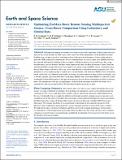Files in this item
Optimizing ExoMars rover remote sensing multispectral science : cross-rover comparison using laboratory and orbital data
Item metadata
| dc.contributor.author | Grindrod, P. M. | |
| dc.contributor.author | Stabbins, R. B. | |
| dc.contributor.author | Motaghian, S. | |
| dc.contributor.author | Allender, E. J. | |
| dc.contributor.author | Cousins, C. R. | |
| dc.contributor.author | Rice, M. S. | |
| dc.contributor.author | Stephan, K. | |
| dc.date.accessioned | 2022-06-20T08:30:02Z | |
| dc.date.available | 2022-06-20T08:30:02Z | |
| dc.date.issued | 2022-06-16 | |
| dc.identifier | 279750616 | |
| dc.identifier | 25f7f205-f34c-433e-8396-8fa83c4da2a0 | |
| dc.identifier | 85133041978 | |
| dc.identifier | 000813041800001 | |
| dc.identifier.citation | Grindrod , P M , Stabbins , R B , Motaghian , S , Allender , E J , Cousins , C R , Rice , M S & Stephan , K 2022 , ' Optimizing ExoMars rover remote sensing multispectral science : cross-rover comparison using laboratory and orbital data ' , Earth and Space Science , vol. 9 , no. 6 , e2022EA002243 . https://doi.org/10.1029/2022EA002243 | en |
| dc.identifier.issn | 2333-5084 | |
| dc.identifier.other | RIS: urn:6B794002580C0CE8E7968D9295FFBC90 | |
| dc.identifier.other | ORCID: /0000-0002-3954-8079/work/114641122 | |
| dc.identifier.uri | https://hdl.handle.net/10023/25547 | |
| dc.description | PMG, RBS, CRC, and EJA thank the UK Space Agency for support (grant ST/T001747/1). SM acknowledges a UK Science and Technology Facilities Council (STFC) PhD studentship (grant ST/R504961/1). | en |
| dc.description.abstract | Multispectral imaging instruments have been core payload components of Mars lander and rover missions for several decades. In order to place into context the future performance of the ExoMars Rosalind Franklin rover, we have carried out a detailed analysis of the spectral performance of three visible and near-infrared (VNIR) multispectral instruments. We have determined the root mean square error (RMSE) between the expected multispectral sampling of the instruments and high-resolution spectral reflectance data, using both laboratory spectral libraries and Mars orbital hyperspectral data. ExoMars Panoramic Camera (PanCam) and Mars2020 Perseverance Mastcam-Z instruments have similar values of RMSE, and are consistently lower than for Mars Science Laboratory Mastcam, across both laboratory and orbital remote sensing data sets. The performance across mineral groups is similar across all instruments, with the lowest RMSE values for hematite, basalt, and basaltic soil. Minerals with broader, or absent, absorption features in these visible wavelengths, such as olivine, saponite, and vermiculite have overall larger RMSE values. Instrument RMSE as a function of filter wavelength and bandwidth suggests that spectral parameters that use shorter wavelengths are likely to perform better. Our simulations of the spectral performance of the PanCam instrument will allow the future use of targeted filter selection during ExoMars 2022 Rosalind Franklin operations on Mars. | |
| dc.format.extent | 17 | |
| dc.format.extent | 6112176 | |
| dc.language.iso | eng | |
| dc.relation.ispartof | Earth and Space Science | en |
| dc.subject | Mars | en |
| dc.subject | Multispectral | en |
| dc.subject | ExoMars | en |
| dc.subject | Spectroscopy | en |
| dc.subject | Mineral | en |
| dc.subject | QC Physics | en |
| dc.subject | QB Astronomy | en |
| dc.subject | DAS | en |
| dc.subject.lcc | QC | en |
| dc.subject.lcc | QB | en |
| dc.title | Optimizing ExoMars rover remote sensing multispectral science : cross-rover comparison using laboratory and orbital data | en |
| dc.type | Journal article | en |
| dc.contributor.institution | University of St Andrews. School of Earth & Environmental Sciences | en |
| dc.contributor.institution | University of St Andrews. St Andrews Centre for Exoplanet Science | en |
| dc.identifier.doi | 10.1029/2022EA002243 | |
| dc.description.status | Peer reviewed | en |
This item appears in the following Collection(s)
Items in the St Andrews Research Repository are protected by copyright, with all rights reserved, unless otherwise indicated.

